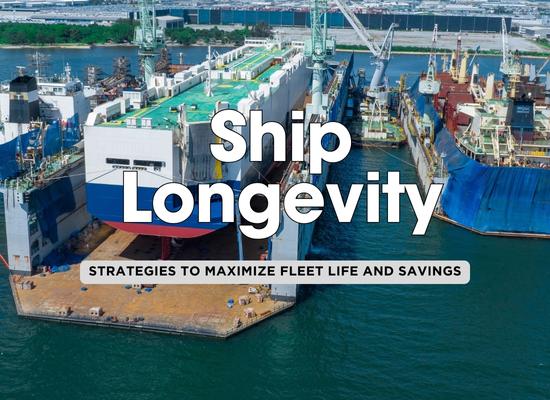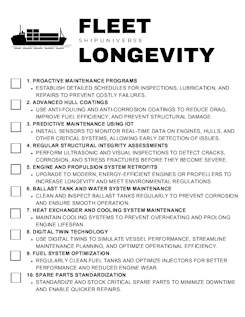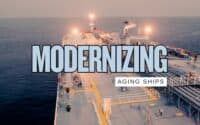Fleet Longevity: 20 Key Strategies to Extend the Life of Your Ships

Extending the lifespan of a fleet can lead to massive savings. Replacing a single vessel can cost millions, while strategic maintenance and upgrades can achieve the same results for a fraction of the price. By focusing on proactive care, advanced technologies, and eco-friendly solutions, shipowners can reduce costs, avoid downtime, and maximize profitability. Today, we highlight 20 essential strategies to help you keep your fleet running efficiently for years to come.


Print Fleet Longevity Checklist
1️⃣ Proactive Maintenance Programs ⚙️
- What It Is: A structured system for scheduled inspections, lubrication, and repairs to prevent costly failures.
- Why It’s Important: Preventive measures ensure small issues don’t escalate into major problems, minimizing downtime and preserving vessel value.
How to Implement:
- Develop a Maintenance Calendar: Set intervals for routine inspections and component servicing based on manufacturer recommendations.
- Record and Analyze: Use maintenance logs to identify patterns and address recurring issues.
- Involve Certified Technicians: Schedule periodic professional assessments of critical components like engines, cooling systems, and structural integrity.
- Daily Crew Inspections: Empower crew to report anomalies promptly for early intervention.
Industry Data:
- Research from maritime maintenance reports indicates proactive programs reduce emergency repair costs by 20-30% compared to reactive strategies.
- Extending the lifespan of engines and propulsion systems by 5-10 years is achievable with consistent care.
Benefits:
- Minimizes downtime and repair costs.
- Boosts fleet operational reliability and efficiency.
2️⃣ Advanced Hull Coatings 🎨
- What It Is: Application of anti-fouling and anti-corrosion coatings to minimize drag, improve fuel efficiency, and prevent structural damage.
- Why It’s Important: A clean, well-maintained hull reduces operational costs and ensures structural longevity.
How to Implement:
- Select the Right Coating: Choose coatings suited to operational waters. Biocide-infused coatings are effective in tropical waters with high marine growth.
- Apply During Dry-Docking: Integrate coating applications with routine dry-dock schedules to reduce downtime.
- Schedule Hull Cleanings: Even advanced coatings need regular cleaning to optimize performance.
Industry Data:
- According to IMO studies, effective anti-fouling coatings can improve fuel efficiency by up to 10%, depending on water conditions.
- Biofouling removal and coating upgrades can reduce overall operating costs by 5-7% annually for large fleets.
Benefits:
- Saves fuel costs and reduces CO₂ emissions.
- Prevents long-term structural degradation from corrosion.
3️⃣ Predictive Maintenance Using IoT 📡
- What It Is: Using IoT sensors to monitor real-time data on key systems, enabling early detection of anomalies and efficient scheduling of maintenance.
- Why It’s Important: Reduces unplanned downtime and extends component lifespan by addressing issues before they escalate.
How to Implement:
- Install Sensors: Equip engines, propellers, and cooling systems with sensors to track vibration, temperature, and pressure.
- Data Monitoring Software: Use integrated platforms to analyze sensor data and trigger alerts for irregularities.
- Crew Training: Teach crews to interpret alerts and execute timely corrective actions.
Industry Data:
- Studies from maritime digitalization efforts show IoT-enabled predictive maintenance reduces unplanned downtime by 25-30%.
- Extends the lifespan of high-wear components by up to 15-20% through early interventions.
Benefits:
- Prevents costly failures and maximizes vessel uptime.
- Improves safety by addressing potential risks before they escalate.
4️⃣ Regular Structural Integrity Assessments 🔍
- What It Is: Systematic evaluations of a vessel's structure using ultrasonic, visual, and non-destructive testing (NDT) methods to identify cracks, corrosion, or stress fractures early.
- Why It’s Important: Catching structural weaknesses early prevents catastrophic failures, enhances safety, and maintains the vessel's operational longevity.
How to Implement:
- Ultrasonic Testing: Use ultrasonic gauges to measure the thickness of hull plates and detect internal corrosion.
- Visual Inspections: Conduct routine inspections for visible cracks, dents, or weld damage.
- Focus on High-Stress Areas: Pay extra attention to critical points like engine mounts, frames, and bulkheads.
- Leverage Professional Services: Partner with classification societies or certified surveyors for periodic assessments.
Industry Data:
- Routine structural inspections can reduce major repair costs by 20-25% over a vessel's lifecycle.
- Vessels with regular integrity assessments demonstrate 10-15% longer operational lifespans.
Benefits:
- Prevents costly downtime from structural failures.
- Ensures compliance with safety regulations and certifications.
5️⃣ Engine and Propulsion System Retrofits 🚀
- What It Is: Upgrading to energy-efficient engines, advanced propulsion systems, or alternative fuels to improve vessel performance and meet regulatory standards.
- Why It’s Important: Modern retrofits reduce fuel consumption, emissions, and wear on outdated systems, enhancing both efficiency and longevity.
How to Implement:
- Assess Retrofit Options: Evaluate engine upgrades, LNG conversions, or propeller optimizations.
- Plan During Dry-Docking: Schedule retrofits during dry-docking to minimize operational disruptions.
- Optimize Propellers: Consider adding energy-saving devices like Mewis ducts or replacing with contra-rotating propellers.
- Invest in Hybrid Systems: For smaller vessels, hybrid power systems offer reduced engine strain.
Industry Data:
- Modern retrofits can lower fuel consumption by 10-20%, according to IMO findings.
- Reduces maintenance costs on older systems by up to 30%.
Benefits:
- Complies with emissions regulations, avoiding penalties.
- Enhances overall operational efficiency and profitability.
6️⃣ Ballast Tank and Water System Maintenance 💧
- What It Is: Routine cleaning and inspection of ballast tanks to prevent corrosion, biofouling, and mechanical failure of water systems.
- Why It’s Important: Ballast tanks are prone to corrosion and contamination, which can impact vessel stability, safety, and compliance with international regulations.
How to Implement:
- Regular Cleaning: Remove sludge, rust, and biofouling during routine maintenance intervals.
- Inspect for Corrosion: Use ultrasonic or visual inspections to detect early signs of wear.
- Apply Protective Coatings: Use anti-corrosion coatings to extend the tank's lifespan.
- Monitor Ballast Water Quality: Ensure compliance with ballast water management systems (BWMS) and international standards.
Industry Data:
- Regular ballast maintenance can extend tank lifespan by 5-10 years.
- Cleaning and coating applications reduce long-term repair costs by up to 20%.
Benefits:
- Maintains vessel stability and safety.
- Ensures compliance with ballast water discharge regulations, avoiding fines.
7️⃣ Heat Exchanger and Cooling System Maintenance ❄️
- What It Is: Regular upkeep of the cooling system and heat exchangers to prevent overheating and ensure optimal engine performance.
- Why It’s Important: Cooling systems are essential for maintaining engine temperature, preventing damage, and ensuring efficiency during prolonged operations.
How to Implement:
- Routine Cleaning: Flush heat exchangers and cooling systems to remove scale, debris, and sediment buildup.
- Inspect for Leaks: Check hoses, seals, and connections for potential leaks or wear.
- Monitor Performance: Use temperature sensors to detect efficiency drops, which may indicate blockages or degradation.
- Replace Components as Needed: Replace worn gaskets, impellers, or other cooling system parts before they fail.
Industry Data:
- Proper cooling system maintenance can reduce engine overheating incidents by 40-50%, extending engine lifespan.
- Heat exchanger cleaning improves efficiency, reducing fuel consumption by up to 5% in high-usage vessels.
Benefits:
- Prevents costly engine repairs due to overheating.
- Optimizes operational efficiency, saving fuel and extending component longevity.
8️⃣ Digital Twin Technology 🌐
- What It Is: A virtual model of a vessel or its components used for real-time monitoring, simulation, and predictive planning.
- Why It’s Important: Digital twins help optimize operations, streamline maintenance schedules, and improve decision-making by simulating vessel performance under various scenarios.
How to Implement:
- Create the Digital Twin: Work with tech providers to build a virtual replica of your vessel using real-time data inputs.
- Integrate Sensors: Use IoT devices to feed data into the model for continuous monitoring.
- Simulate Scenarios: Test operational adjustments, maintenance schedules, and upgrades virtually before implementing them.
- Train Crews: Familiarize crew members with digital twin platforms for better monitoring and responsiveness.
Industry Data:
- According to maritime digitalization studies, adopting digital twins can reduce maintenance costs by 20-30%.
- Enhances operational efficiency by optimizing vessel routes and fuel usage, saving up to 10% annually.
Benefits:
- Identifies inefficiencies and potential failures before they occur.
- Improves operational planning and reduces downtime.
9️⃣ Fuel System Optimization ⛽
- What It Is: Regular maintenance and improvements to the fuel system to ensure efficient engine performance and reduce wear.
- Why It’s Important: Fuel system efficiency directly impacts engine reliability, fuel consumption, and overall operational costs.
How to Implement:
- Clean Fuel Tanks Regularly: Remove sediment and water contamination to prevent clogs and corrosion.
- Inspect Fuel Lines: Check for leaks or blockages that could disrupt fuel flow.
- Optimize Injectors: Regularly clean or replace fuel injectors to maintain efficient combustion.
- Use Additives: Introduce high-quality fuel additives to improve performance and reduce carbon deposits.
Industry Data:
- Optimized fuel systems can improve fuel efficiency by 3-5% and reduce engine wear by up to 15%.
- Preventive maintenance of injectors and filters cuts downtime caused by fuel-related issues by 20-30%.
Benefits:
- Lowers fuel costs and increases engine lifespan.
- Reduces risks of fuel contamination and associated repairs.
🔟 Spare Parts Standardization 🛠️
- What It Is: Establishing a standardized inventory of critical spare parts across the fleet to ensure quick replacements and minimize downtime.
- Why It’s Important: Delays in sourcing parts during emergencies can lead to prolonged vessel inactivity, impacting profitability and operations.
How to Implement:
- Identify Critical Components: Focus on high-risk items such as engine parts, propellers, seals, and pumps.
- Streamline Inventory Across Fleet: Use standardized parts that are compatible with multiple vessels in your fleet.
- Strategic Storage Locations: Store spare parts at key ports or onboard for immediate availability.
- Digitize Inventory Management: Use software to monitor stock levels and automate restocking.
Industry Data:
- Standardizing spare parts reduces repair time by up to 50% in cases of component failure.
- Can lower procurement costs by 10-15% through bulk purchasing and reduced shipping expenses.
Benefits:
- Minimizes repair delays, reducing downtime.
- Enhances operational reliability and ensures quick responses during emergencies.
1️⃣1️⃣ Anti-Biofouling Measures 🌊
- What It Is: A combination of advanced coatings and routine hull cleanings to combat marine growth, reduce drag, and maintain operational efficiency.
- Why It’s Important: Biofouling increases fuel consumption and accelerates hull degradation, directly impacting operational costs.
How to Implement:
- Apply Anti-Fouling Coatings: Use silicone-based or biocide-infused coatings to prevent marine growth.
- Schedule Regular Cleanings: Conduct underwater hull cleanings between dry-dock intervals to maintain smooth surfaces.
- Monitor Hull Condition: Use ROVs (Remotely Operated Vehicles) to inspect for biofouling and damage regularly.
- Adopt Biofouling Management Plans: Ensure compliance with IMO biofouling guidelines to avoid fines and inefficiencies.
Industry Data:
- Biofouling removal can improve fuel efficiency by 5-10%, depending on operating conditions.
- Reduces hull maintenance costs by up to 15-20% over the vessel's lifecycle.
Benefits:
- Cuts fuel costs and emissions by improving hydrodynamics.
- Extends hull lifespan by preventing corrosion linked to marine growth.
1️⃣2️⃣ Advanced Crew Training 👨✈️
- What It Is: Comprehensive training programs for crew members on efficient vessel operation, troubleshooting, and maintenance best practices.
- Why It’s Important: A well-trained crew reduces the risk of mishandling equipment, minimizes operational errors, and ensures swift responses during emergencies.
How to Implement:
- Focus on Key Areas: Include fuel optimization, engine operation, and emergency procedures in training modules.
- Use Simulation-Based Training: Leverage simulators to prepare crews for real-world challenges without risks.
- Offer Refresher Courses: Provide ongoing training to keep crews updated on the latest technology and practices.
- Evaluate Performance: Use assessments to identify skill gaps and tailor training accordingly.
Industry Data:
- Companies that invest in advanced crew training report 20-30% fewer operational errors and improved fuel efficiency.
- Better-trained crews can extend component lifespan by 10-15% through proper handling and maintenance.
Benefits:
- Enhances vessel performance and safety.
- Reduces long-term repair costs associated with mishandling or improper maintenance.
1️⃣3️⃣ Emergency Preparedness and Redundancy 🚨
- What It Is: Ensuring vessels are equipped with redundant systems for critical operations and training crews to respond effectively to emergencies.
- Why It’s Important: Redundancy and preparedness minimize risks during equipment failures, weather crises, or other unforeseen incidents, protecting both crew and assets.
How to Implement:
- Install Redundant Systems: Equip vessels with backup navigation, communication, and power systems to maintain functionality during failures.
- Conduct Regular Drills: Train crews on emergency protocols, such as fire response, engine failure, and collision scenarios.
- Safety Equipment Maintenance: Regularly inspect and replace safety gear, such as life rafts, fire extinguishers, and emergency lighting.
- Establish Communication Plans: Ensure clear, reliable communication protocols for emergencies at sea.
Industry Data:
- Well-prepared vessels report 40% fewer major incidents, according to maritime safety studies.
- Redundancy systems reduce downtime by up to 20% during equipment failures.
Benefits:
- Enhances crew safety and vessel resilience.
- Reduces operational disruptions and the likelihood of severe damages.
1️⃣4️⃣ Modular System Retrofitting 🛠️
- What It Is: Upgrading outdated systems with modular components to simplify repairs, upgrades, and replacements.
- Why It’s Important: Modular systems are easier to maintain and adapt, reducing downtime and long-term costs.
How to Implement:
- Identify Key Systems for Retrofitting: Focus on engines, navigation, and propulsion systems.
- Work with Suppliers: Source modular components compatible with your fleet’s requirements.
- Integrate During Dry-Docking: Combine retrofitting with routine dry-docking schedules for minimal disruption.
- Plan for Future Upgrades: Modular designs allow for seamless integration of future technologies.
Industry Data:
- Modular retrofitting reduces maintenance time by 30-40%, allowing for faster repairs.
- Extends the functional lifespan of critical systems by 10-15 years with periodic upgrades.
Benefits:
- Reduces long-term maintenance costs.
- Future-proofs vessels for evolving regulatory and operational requirements.
1️⃣5️⃣ Comprehensive Corrosion Management Program 🛡️
- What It Is: A dedicated program to prevent and repair corrosion in critical areas, such as ballast tanks, cargo holds, and engine rooms.
- Why It’s Important: Corrosion is a leading cause of structural and mechanical failures, and managing it proactively ensures vessel longevity and safety.
How to Implement:
- Protective Coatings: Apply anti-corrosion coatings to hulls, tanks, and vulnerable components.
- Sacrificial Anodes: Use anodes to prevent corrosion in high-risk areas like ballast tanks.
- Routine Inspections: Perform regular inspections using ultrasonic testing or other NDT methods to detect early corrosion.
- Replace Damaged Areas: Promptly repair or replace corroded sections to prevent further deterioration.
Industry Data:
- Effective corrosion management reduces structural repair costs by 20-30% over a vessel’s lifespan.
- Regular use of coatings and anodes extends hull life by 5-10 years.
Benefits:
- Maintains structural integrity and safety.
- Reduces unexpected repair costs and downtime.
1️⃣6️⃣ Propulsion Enhancements 🚀
- What It Is: Upgrading propulsion systems with advanced technologies like Mewis ducts, contra-rotating propellers, or energy-saving fins to improve efficiency and reduce wear.
- Why It’s Important: Enhanced propulsion systems reduce fuel consumption, extend system lifespan, and comply with environmental regulations.
How to Implement:
- Install Energy-Saving Devices: Fit Mewis ducts, propeller boss cap fins, or similar devices to optimize flow dynamics.
- Upgrade Propellers: Replace aging propellers with contra-rotating or high-efficiency designs tailored to the vessel’s needs.
- Align Upgrades with Maintenance Schedules: Combine propulsion enhancements with other planned repairs to reduce downtime.
- Monitor Results: Use performance tracking tools to measure the impact on efficiency and fuel savings post-upgrade.
Industry Data:
- Advanced propulsion upgrades can reduce fuel consumption by 5-10%, according to studies by the IMO and propulsion manufacturers.
- Retrofitting propulsion systems often results in operational cost reductions of up to 15% annually.
Benefits:
- Cuts operational costs by lowering fuel usage.
- Extends propulsion system lifespan, reducing repair frequency.
1️⃣7️⃣ Lifecycle Cost Analysis 📊
- What It Is: A systematic evaluation of whether to repair, upgrade, or replace vessels based on their operational efficiency, maintenance costs, and future value.
- Why It’s Important: Helps shipowners make informed financial decisions to maximize fleet value and minimize wasteful spending.
How to Implement:
- Assess Current Maintenance Costs: Track ongoing expenses for repairs, fuel, and compliance upgrades.
- Project Future Costs: Estimate costs for potential retrofits or replacements based on vessel age and regulatory changes.
- Incorporate Operational Efficiency Data: Use data on fuel consumption, downtime, and repair frequency to gauge efficiency.
- Compare Against Replacement Costs: Evaluate whether upgrading or purchasing a newer vessel offers better long-term returns.
Industry Data:
- Fleets that adopt lifecycle cost analysis report savings of 20-25% by avoiding unnecessary repairs or untimely replacements.
- Older vessels with regular upgrades can maintain up to 90% operational efficiency compared to newbuilds.
Benefits:
- Ensures financial resources are allocated effectively.
- Prevents over-investment in aging vessels or premature replacements.
1️⃣8️⃣ Regular Dry-Docking with Full Inspections ⚓
- What It Is: Utilizing mandatory dry-docking periods to conduct thorough inspections, complete maintenance, and implement retrofitting upgrades.
- Why It’s Important: Dry-docking provides a unique opportunity to address underwater components and structural issues that are otherwise inaccessible.
How to Implement:
- Plan Comprehensive Inspections: Schedule ultrasonic testing, hull surveys, and machinery evaluations during dry-docking.
- Combine Maintenance Tasks: Address anti-fouling coatings, propulsion system repairs, and ballast tank cleaning simultaneously.
- Leverage Class Society Guidance: Work with classification societies to ensure inspections meet regulatory standards.
- Document Work: Maintain detailed records of repairs and upgrades for future reference and compliance checks.
Industry Data:
- A well-planned dry-docking cycle can reduce long-term maintenance costs by 20-30% and extend vessel lifespan by 5-10 years.
- Efficient use of dry-docking periods reduces operational downtime by up to 15-20% annually.
Benefits:
- Allows for comprehensive maintenance in one session, reducing disruptions.
- Ensures compliance with international maritime standards.
1️⃣9️⃣ High-Performance Lubricants 🛢️
- What It Is: Utilizing advanced lubricants specifically designed to minimize friction, reduce wear, and enhance the performance of engines and mechanical systems.
- Why It’s Important: High-performance lubricants improve efficiency, extend component lifespan, and lower maintenance costs by reducing stress on critical systems.
How to Implement:
- Select Premium Lubricants: Choose lubricants engineered for marine applications, such as synthetic oils or eco-friendly alternatives.
- Monitor Lubricant Quality: Regularly analyze lubricant conditions using onboard tools or laboratory testing.
- Optimize Lubricant Usage: Apply the appropriate amount to prevent waste while ensuring sufficient protection.
- Train Crew: Educate crew members on proper lubricant application and monitoring techniques.
Industry Data:
- Using advanced lubricants can reduce engine wear by 20-30%, extending component lifespan.
- Improved efficiency from optimized lubrication can result in 2-5% fuel savings annually.
Benefits:
- Enhances engine and system performance.
- Reduces repair and replacement costs over the long term.
2️⃣0️⃣ Alignment with Environmental Regulations 🌱
- What It Is: Adopting eco-friendly technologies, alternative fuels, and carbon capture systems to comply with evolving environmental regulations.
- Why It’s Important: Staying compliant not only avoids penalties but also ensures fleet sustainability and long-term operational viability.
How to Implement:
- Adopt Alternative Fuels: Transition to low-sulfur fuel, LNG, or biofuels to meet IMO sulfur caps and emission standards.
- Install Emission Reduction Technologies: Equip vessels with scrubbers or carbon capture systems to mitigate environmental impact.
- Incorporate Renewable Energy: Use wind-assisted propulsion, solar panels, or hybrid power systems for greener operations.
- Stay Updated on Regulations: Regularly review global and regional environmental laws to ensure compliance.
Industry Data:
- Vessels using alternative fuels report up to 50% reductions in sulfur oxide emissions.
- Implementing carbon capture systems can reduce CO₂ emissions by 10-30%, depending on the technology.
Benefits:
- Ensures compliance with IMO and other international standards.
- Improves operational efficiency while reducing the environmental footprint.
Operating a maritime fleet demands vigilance, innovation, and strategic planning. From proactive maintenance to aligning with environmental regulations, every decision you make impacts the longevity, efficiency, and profitability of your vessels. By implementing these 20 proven strategies, shipowners can not only extend the life of their fleet but also position themselves for success in a rapidly evolving industry.
Take the first step today by evaluating your fleet’s current practices and identifying areas for improvement. Whether it’s adopting new technologies or refining maintenance routines, each effort contributes to a stronger, more sustainable future for your operations.
Table Summary
| ShipUniverse: Extending the Life of Your Fleet | |||
| Strategy | Description | Benefits | How to Apply |
| Proactive Maintenance Programs | Scheduled inspections, lubrication, and repairs to prevent costly failures. | Minimizes downtime and avoids expensive emergency repairs. | Develop a detailed schedule, keep maintenance logs, and involve trained crew and certified technicians. |
| Advanced Hull Coatings | Anti-fouling and anti-corrosion coatings to reduce drag and structural damage. | Improves fuel efficiency, protects against corrosion, and reduces long-term costs. | Apply coatings during dry-docking and conduct routine hull cleanings. |
| Predictive Maintenance Using IoT | IoT sensors monitor real-time conditions to catch issues early. | Reduces unplanned downtime and extends component lifespan. | Install sensors, analyze data, and train crews to respond to alerts effectively. |
| Regular Structural Integrity Assessments | Non-destructive testing (NDT) and visual inspections to identify damage. | Prevents major structural failures and maintains safety standards. | Use ultrasonic testing and focus on high-stress areas like bulkheads and welds. |
| Engine and Propulsion System Retrofits | Upgrading engines or propellers to improve efficiency and reduce wear. | Reduces fuel consumption and meets environmental regulations. | Schedule retrofits during dry-docking and use energy-saving devices like Mewis ducts. |
| Ballast Tank and Water System Maintenance | Cleaning and inspecting ballast tanks to prevent corrosion and contamination. | Ensures vessel stability and prevents costly damage or fines. | Clean tanks regularly, apply protective coatings, and monitor water quality. |
| Heat Exchanger and Cooling System Maintenance | Maintaining cooling systems to prevent overheating and ensure efficiency. | Prevents engine damage and reduces repair costs. | Flush systems, inspect for leaks, and replace worn components as needed. |
| Digital Twin Technology | Virtual replicas of vessels to simulate performance and optimize maintenance. | Improves planning, reduces downtime, and optimizes operations. | Integrate IoT sensors and use software for real-time monitoring and scenario testing. |
| Fuel System Optimization | Maintaining fuel tanks, lines, and injectors to ensure efficient performance. | Reduces fuel costs and prevents engine damage. | Clean tanks, inspect lines for leaks, and use high-quality additives. |
| Spare Parts Standardization | Standardizing and stocking critical spare parts to reduce downtime. | Prevents repair delays and ensures operational reliability. | Identify high-risk components, centralize inventory, and use inventory management tools. |
| Anti-Biofouling Measures | Combining advanced coatings with regular hull cleanings to combat marine growth. | Improves fuel efficiency and reduces hull maintenance costs. | Apply anti-fouling coatings, schedule cleanings, and use ROVs for inspections. |
| Advanced Crew Training | Providing comprehensive training for efficient operations and maintenance. | Reduces mishandling, minimizes operational errors, and enhances safety. | Use simulators, offer ongoing training, and focus on troubleshooting techniques. |
| Emergency Preparedness and Redundancy | Equipping vessels with redundant systems and conducting emergency drills. | Ensures safety and reduces disruptions during unforeseen incidents. | Install backup systems, conduct drills, and maintain safety equipment. |
| Modular System Retrofitting | Replacing outdated systems with modular designs for easier upgrades. | Simplifies maintenance and adapts easily to future technologies. | Focus on engines and navigation systems during dry-docking for retrofitting. |
| Comprehensive Corrosion Management | Dedicated efforts to monitor, prevent, and repair corrosion. | Prevents structural failures and reduces long-term repair costs. | Apply coatings, use sacrificial anodes, and perform regular inspections. |
| Propulsion Enhancements | Upgrading propulsion systems with technologies like Mewis ducts. | Improves efficiency, reduces fuel costs, and extends system life. | Install energy-saving devices and upgrade during scheduled maintenance. |
| Lifecycle Cost Analysis | Evaluating whether to repair, upgrade, or replace vessels based on cost-effectiveness. | Maximizes fleet value and prevents wasteful spending. | Track maintenance costs, project future expenses, and compare replacement options. |
| Regular Dry-Docking with Full Inspections | Using dry-docking periods for inspections, maintenance, and retrofits. | Addresses underwater components and ensures compliance. | Plan comprehensive surveys, combine tasks, and document upgrades. |
| High-Performance Lubricants | Using advanced lubricants to reduce friction and extend system life. | Improves efficiency and reduces wear on critical systems. | Select premium lubricants, monitor quality, and train crews on application. |
| Alignment with Environmental Regulations | Adopting eco-friendly technologies and alternative fuels. | Ensures compliance, reduces emissions, and enhances sustainability. | Use alternative fuels, install scrubbers, and stay updated on regulations. |

Do you have a Maritime Product or Service that may be of interest to Shipowners? Tell us about it here!
Do you have feedback or insights? Please reach out to editor @ shipuniverse.com



